Art Fairs
5 Discoveries From This Year’s Art Basel Miami Beach
Gonzo art history, gorgeous works of high-concept craft, and more.
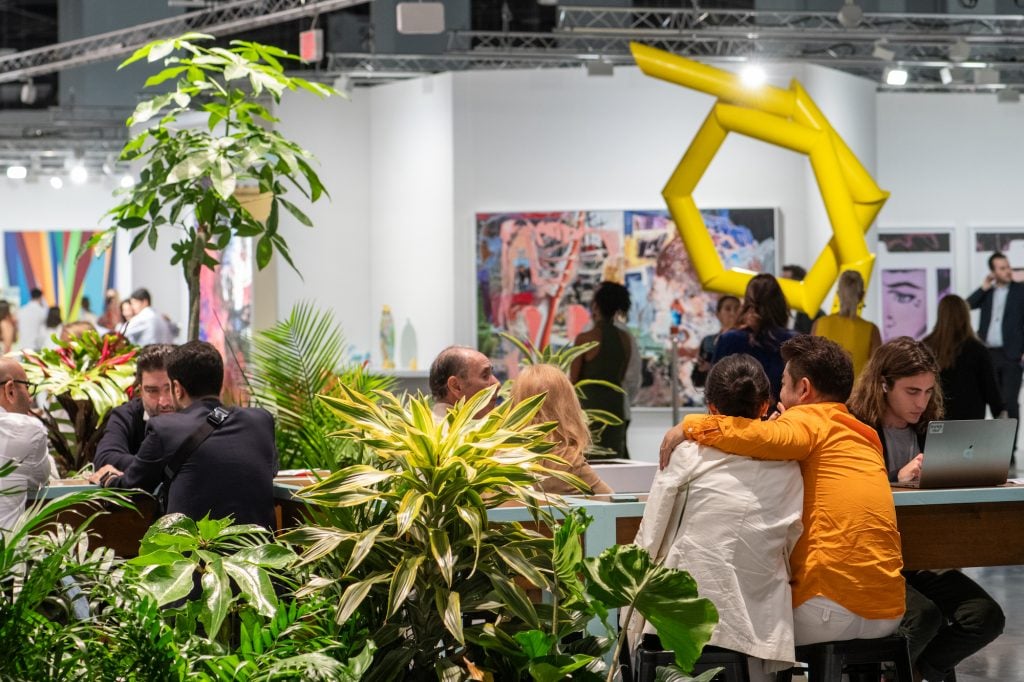
Gonzo art history, gorgeous works of high-concept craft, and more.

Naomi Rea

Speaking about Miami collectors, an advisor once told me that “all of their taste is in their mouth.” That assessment has certainly rung true for at least parts of this week, as Art Basel Miami Beach (a.k.a. “the fun Basel”) got into the swing of things for its 21st birthday.
To my eye at least, much of the art on view scattered around the city was about as refined as an everlasting gobstopper. Its defining features were cutesy cartoonish figuration, kitsch, and Day-Glo “Instagrammable” installations. As for the big fair itself, at least some of these aesthetics transferred over, as dealers looked to court some of the Magic City’s stupid money following a year of art-market slowdown.
The enormous scale of the Convention Center and the vast real estate afforded to some of the blue chips added further difficulty to the task of choosing the best booth presentation. Commercially motivated to display as much inventory as possible all at once, art fair booths tend to be more chaotic than curated. Still, I can forgive galleries for trying to make the most out of an expensive-to-attend trade fair.
And after all, it is still an Art Basel fair, where there is always plenty of great work to be found for serious collectors who know where to look. This year, some of those collectors may even secure themselves a bargain or two, at least from the dealers who have accepted the new market reality and have priced work to sell.
Here are my 5 top picks out of the presentations brought to the fair.
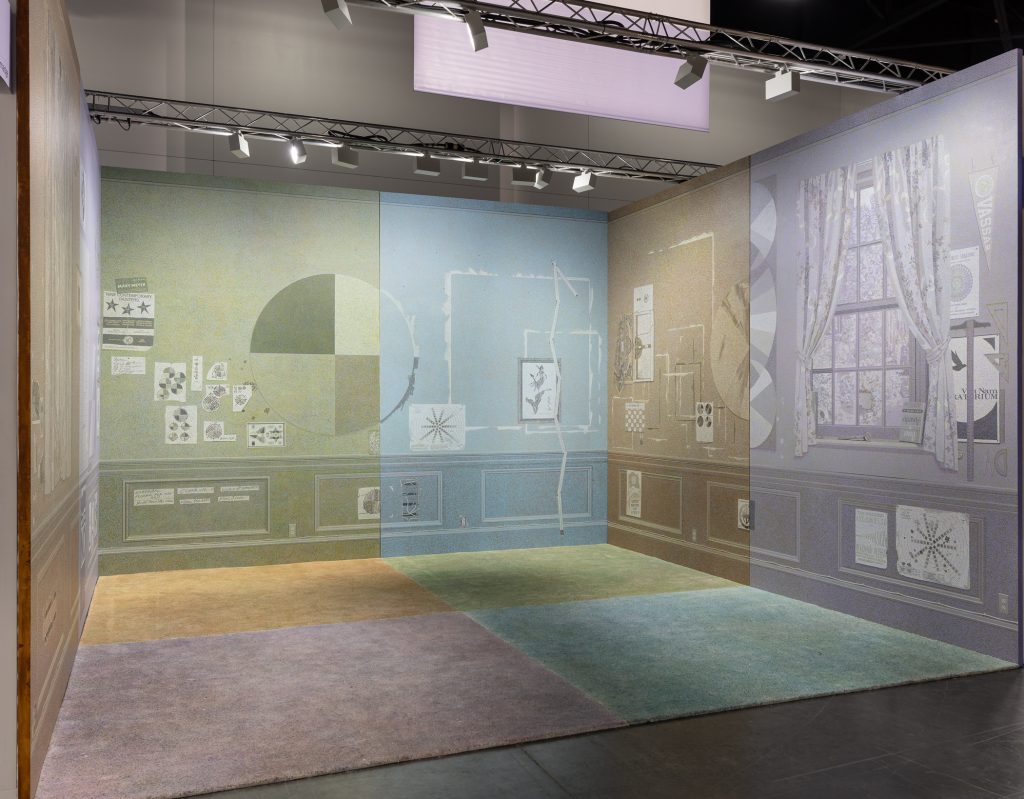
Cynthia Talmadge, Half Light (2023). Installation view, Art Basel Miami Beach 2023. Courtesy 56 Henry.
The New York gallery’s solo presentation of Cynthia Talmadge earns the top spot for marrying conceptual rigor and a compelling narrative arc into an aesthetically pleasing and surprising immersive presentation.
Talmadge’s six large-scale pointillist paintings double as the walls of the booth, which is carpeted to match, forming an ode to a late Washington Color School painter, Mary Pinchot Meyer, and the nebulous circumstances surrounding her death.
Meyer, who was embedded in the social fabric of Georgetown in the 1950s and ‘60s, was married to a top CIA official, and had an affair with John F. Kennedy—before she was murdered on the Chesapeake and Ohio Canal in 1964.
Conspiracy theories have abounded, naturally. Shortly after her death, the CIA allegedly broke into Meyer’s Georgetown studio to retrieve her sketchbook, which may have contained sensitive details about powerful men (one theory insists that she had gotten JFK into psychedelics).
A talented painter, Meyer’s career was cut short. At Art Basel Miami Beach, Talmadge’s surrealist installation recreates Meyer’s studio, replete with hidden clues and speculations about how her practice might have evolved had she survived. The installation’s dreamy palette—lavender, green, blue, and brown—adopts the colors of Meyer’s final painting, Half Light (1964), a circular geometric composition that hangs in the Smithsonian American Art Museum.
Talmadge is known for installations pulling subject matter from “the romantic dark side of contemporary Americana and tabloid culture,” and concepts probing the space between conspiracy and reality. The whole thing gave me goosebumps.
By the end of the first day of the fair, the gallery had received interest and was trying to keep the installation together in one placement. In the case that it is split up, each panel will be priced at $75,000.
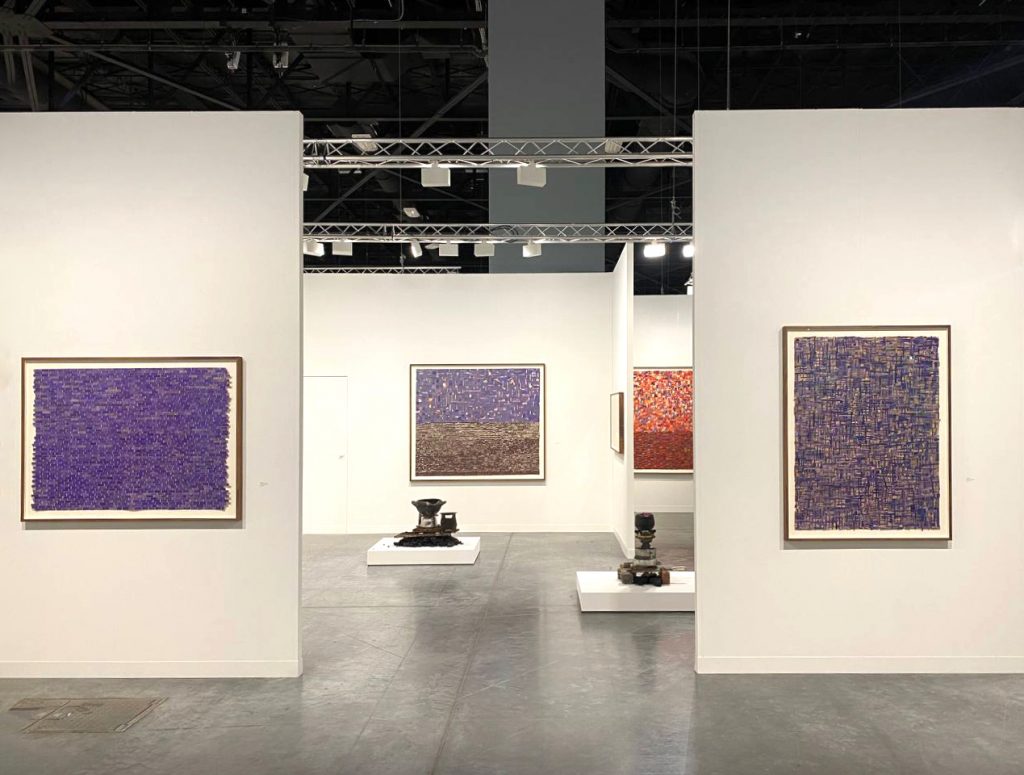
©Antonio Tarsis 2023, courtesy Carlos/Ishikawa, London.
I’ve been familiar with Antonio Tarsis’s work for a while due to his representation by the London gallery Carlos/Ishikawa, but the presentation at Art Basel Miami Beach was too strong not to merit a mention. Born in poverty in 1995, the Brazilian artist left school at age 12. Absent a father, he was effectively orphaned at 14 when his mother died, after which he grew up alone with his siblings in a favela in northern Brazil. Looking to express himself creatively, he fell in love with painting. Unable to afford materials, he adopted what is now a central motif of his work: matchboxes discarded by drug users in the streets. One popular brand is recognizable by its minimalist purple packaging, and the found objects become variously sun-bleached and rain damaged, giving them all slightly different painterly touches.
The booth features several of the artist’s now signature monochrome matchbox collages—assembled in rectangular patchwork, they recall the geometric abstraction of South American modernist painters Hélio Oiticica or Joaquín Torres-García, and the symbolism imbued in the matchboxes speaks anew to issues of colonialism, globalization, and exploitation. The effect of the work is surprisingly uplifting and serene despite its difficult subject matter. New to me also were some sculptural works on the booth featuring candy fruits, void of nutrients.
Price ranges for the works are $8,000–$45,000, and most were already sold by the end of the first VIP day.
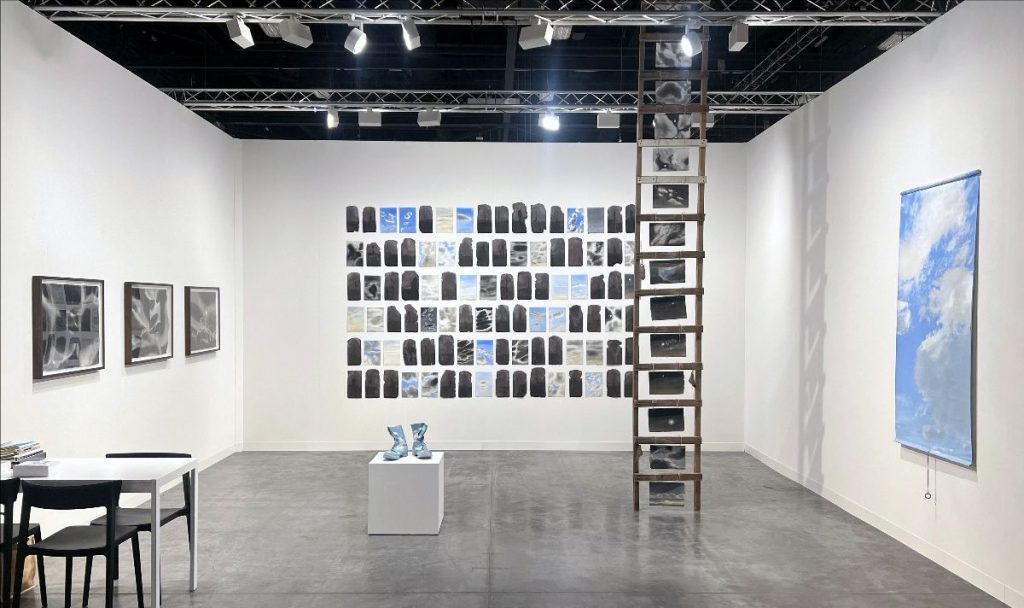
Geoffrey Hendricks. Courtesy Klaus Vin Nichtssagend.
In the fair’s section for art historical projects, Klaus Von Nichtssagend Gallery’s meditative booth is showcasing art by the late U.S. artist Geoffrey Hendricks.
The booth features the artist’s famous paintings of clouds on various media, from watercolors on paper affixed to a 14-foot barn ladder to slate roof tiles and a window shade. Hendricks earned the nickname “Cloudsmith” for his preoccupation with celestial phenomenon, which fueled his ruminations on “impermanence, desire, and possible transcendence.”
Heavily involved in the Fluxus movement in the 1960s and ’70s, Hendricks’s work was often ephemeral, sometimes encompassing performance—his most famous being the Flux Divorce he staged with his wife, the artist Nye Ffarrabas, in 1971. The performance marked the end of their 10-year monogamous union and the opening of their relationship to same-sex partners with a series of rituals that included sawing their bed in half. An important figure in the queer community, Hendricks helped found the Archive Project of Visual AIDS in the 1980s, and also became an influential teacher at Rutgers for nearly half a century, helping to shape the practice of generations of artists, including Pope.L.
Hendricks died in 2018 at the age of 86, and the gallery has been representing the estate for two years. In the early hours of the fair, there had been interest in the work but no confirmed sales, with prices for the work ranging from $40,000 to $120,000.
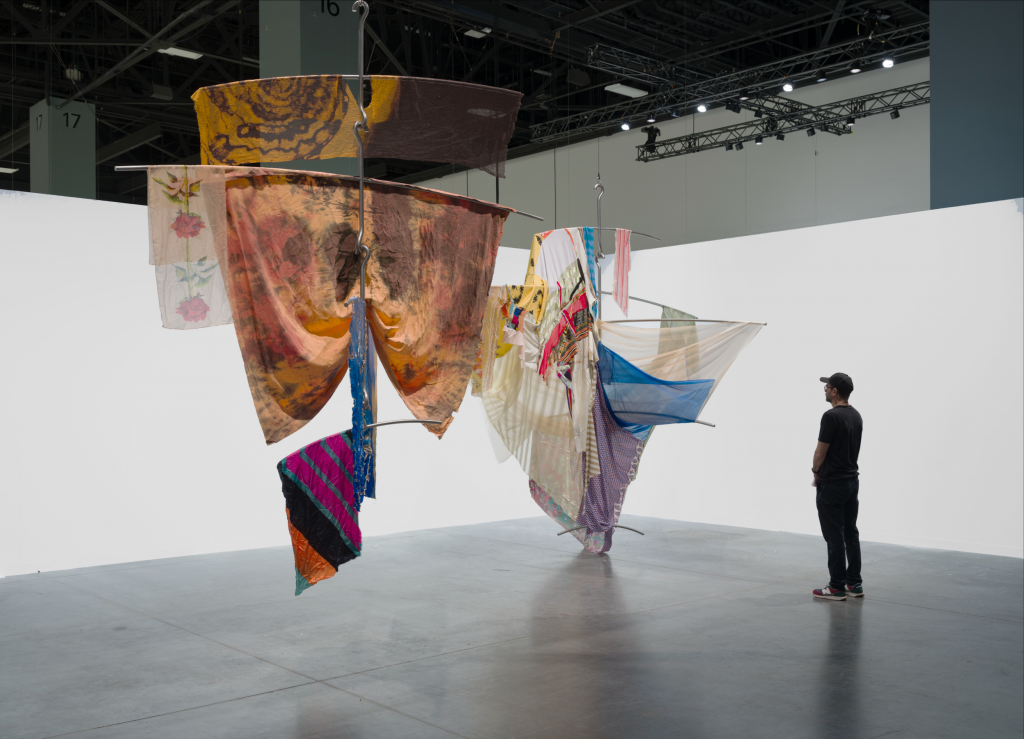
Installation view of Eric N. Mack, Flourish (2023), at Art Basel Miami Beach, Meridians, December 6 – 10, 2023. © Eric N. Mack. Courtesy Paula Cooper Gallery, New York. Photo: Oriol Tarridas.
Technically not a booth, but located in the fair’s sector for statement presentations too large to fit in a standard booth, a set of vast sails hangs from the ceiling, gently floating in the air circulating around the convention center.
This poetic textile installation, made using assorted fabric and cordage affixed to an aluminum structure, is the work of U.S. artist Eric N. Mack.
Titled Flourish, the fabric mobile incorporates two pieces, slowly rotating independently, and uses images from his personal archive, fashion magazines, newspapers, and books to operate as “a prototype for systemic ruptures and changing notions of beauty.”
Born in 1987, Mack studied at the Cooper Union and has had a steadily rising profile; showing in the Whitney Biennial in 2019, as well as influential group shows including the Legacy Russell-curated “The New Bend” in 2022, and has had numerous solo outings. Viewing painting as a “space of questioning,” the artist plays with surface, light, color, and texture, often fusing garments and various textiles with acrylic paint, glitter, and dye.
Paula Cooper is co-presenting this work with Morán Morán and Galleria Franco Noero. With an asking price of between $125,000 and $150,000, the piece was on reserve for a museum by the end of the first VIP day.
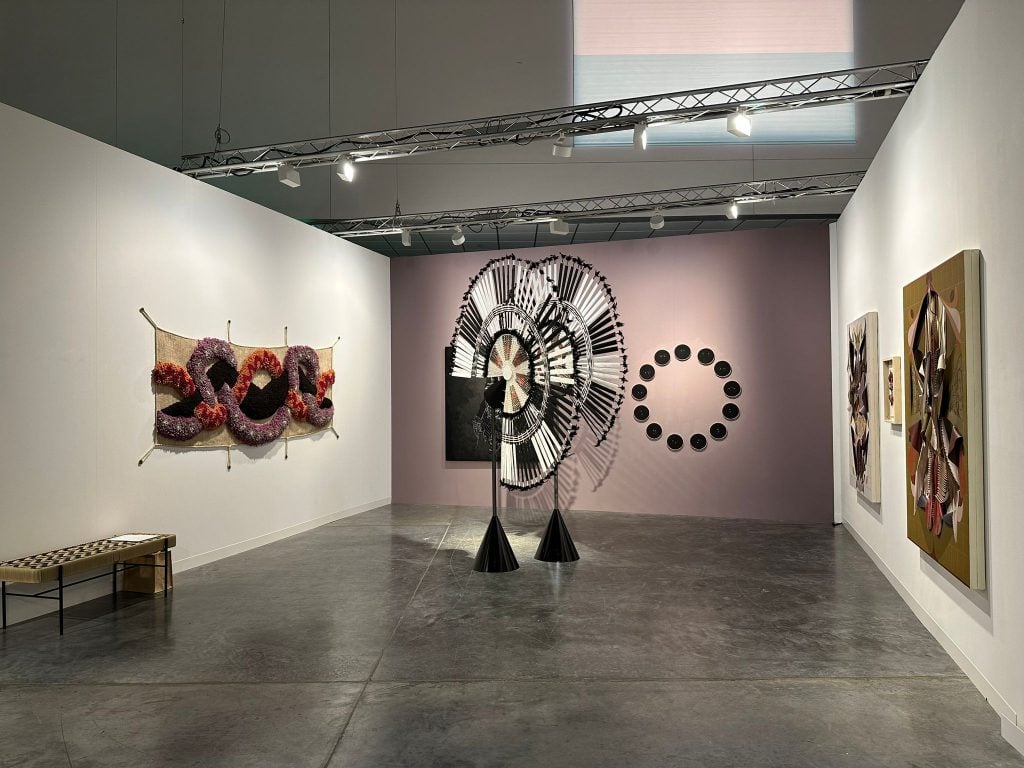
Courtesy Instituto de visión.
In an unobtrusive space located in the Nova section, which is focused on recent works by artists of all generations, Instituto de visión’s booth brings together work by three Latin American women artists responding to societies variously infected with patriarchy, colonialism, and other systems of exploitation.
The 36-year-old Colombian painter Cristina Camacho’s work is a standout. Inspired by 18th-century medical textbooks depicting anatomical dissections, Camacho takes a scalpel to her own paintings, slicing into the painted skin of the canvas. While the aggressive method could result in perverse or violent works, Camacho weaves and reshapes the canvas strips into delicate geometric patterns as an expression of resistance. The precise sculptural paintings that result are beautiful, and there is an ambiguity in their earthen colors and motifs evoking musculature, floral patterns, and female anatomy. Camacho views the surface of her paintings as a direct extension of her own body, and in opening it up, she transforms the three-dimensional canvas into a portal into her world. Prices for the works range from $5,000 to $18,000 depending on size.
Nearby, sculptural work by Mexico City-based Tania Canidiani pays tribute to dances and rituals that have survived the colonial and postcolonial process of cultural erasure. Prices for her work range from $9,000 for smaller embroidered pieces to $55,000 for a larger sculptural work, made with tufts of bamboo, cane, wood, ribbon, paper, and feathers.
Aurora Pellizi’s tapestry executed using a precolonial weaving technology, Ayate, rounds off the presentation. It depicts the ancient myth of the Gorgons, female monsters with a petrifying gaze.
It stands as a remarkable showing for the gallery’s first-time Art Basel outing. And it seems to have paid off: First-day sales were “great” according to the gallery’s artistic director Beatriz Lopez. While some works were still on hold mid-way through the day, Lopez was confident that by end of play they’d be looking at a sold out booth.
More Trending Stories:
Art Critic Jerry Saltz Gets Into an Online Skirmish With A.I. Superstar Refik Anadol
Your Go-To Guide to All the Fairs You Can’t Miss During Miami Art Week 2023
The Old Masters of Comedy: See the Hidden Jokes in 5 Dutch Artworks
David Hockney Lights Up London’s Battersea Power Station With Animated Christmas Trees
On Edge Before Miami Basel, the Art World Is Bracing for ‘the Question’
Thieves Stole More Than $1 Million Worth of Parts From an Anselm Kiefer Sculpture